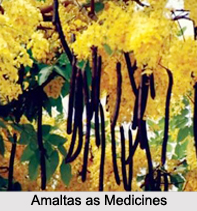 Cassia Fistula is commonly known as Amaltas. It is indigenous to India and is an old medicine of the Hindu Materia Medica. It is a popular ornamental plant and is an herbal medicine. The tree is uncommonly beautiful when in flower, few surpassing it in the elegance of its numerous long pendulous racemes of large bright yellow flowers, intermixed with the young lively green foliage. The tree is categorized into 3 types, namely:
Cassia Fistula is commonly known as Amaltas. It is indigenous to India and is an old medicine of the Hindu Materia Medica. It is a popular ornamental plant and is an herbal medicine. The tree is uncommonly beautiful when in flower, few surpassing it in the elegance of its numerous long pendulous racemes of large bright yellow flowers, intermixed with the young lively green foliage. The tree is categorized into 3 types, namely:
•Cassia Sophora, in Sanskrit "Kasamarda"
•Cassia Tora, in Sanskrit "Chakramarda"
•Cassia Alata, in Sanskrit "Dadrughna"
Health Benefits of Amultas
Amaltas is known as a "disease killer". The pulp of the fruit is used as a mild cathartic. The root is also described as laxative and useful in fevers, heart diseases, retained excretions, biliousness etc. The root, leaves and seeds of Cassia fistula enter into the composition of numerous compound prescriptions. It is described as expectorant and useful in skin diseases, cough and hoarseness, but it does not appear to be much used in these diseases.
Dose of Amultas in Medicine
The compound decoction "Arogbadhadi" which passes by this name is a very commonly used purgative in native practice. To prepare it, take the pulp of Cassia fistula, Picrorrhiza Kurroa (katuki), chebulic myrobalans, long pepper root and the tubers of Cyperus rotundus (mustaka), about 64 grains each, water 32 tolas, and boil down to 8 tolas. Half of this quantity, or in strong constitutions the whole of it, is given for a dose.
The seeds of Cassia Sophora, Raplianus sativus (mulaka) and sulphur, in equal parts, are rubbed into a paste with water and applied to patches of pityriasis and psoriasis. The seeds of Cassia Tora are steeped in the milky juice of Euphorbia neriifolia and afterwards rubbed into a paste with cow"s urine for application to keloid tumours.
Dadrughna signifies as a curer of ringworm. Its leaves are used in this disease. Equal parts of the seeds of Cassia Tora and Pongamia glabra (karanja) with a fourth part of the root of Tinospora cordifolia (gulancha) are rubbed together into a paste and applied in ringworm.
Related Articles
Ayurveda
Ayurveda Medication
Elements of Ayurveda
Concepts of Ayurveda
Ancient Literature of Ayurveda




















